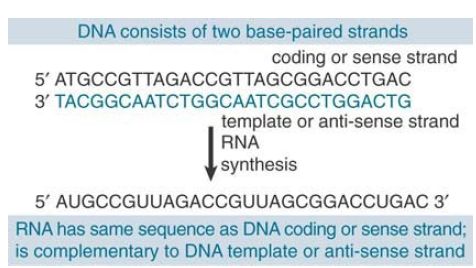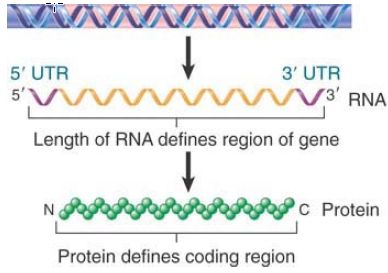


 النبات
النبات
 الحيوان
الحيوان
 الأحياء المجهرية
الأحياء المجهرية
 علم الأمراض
علم الأمراض
 التقانة الإحيائية
التقانة الإحيائية
 التقنية الحيوية المكروبية
التقنية الحيوية المكروبية
 التقنية الحياتية النانوية
التقنية الحياتية النانوية
 علم الأجنة
علم الأجنة
 الأحياء الجزيئي
الأحياء الجزيئي
 علم وظائف الأعضاء
علم وظائف الأعضاء
 الغدد
الغدد
 المضادات الحيوية
المضادات الحيوية|
Read More
Date: 18-5-2016
Date: 7-12-2015
Date: 14-3-2021
|
Several Processes Are Required to Express the Product of a Gene
KEY CONCEPTS
-A typical bacterial gene is expressed by transcription into mRNA and then by translation of the mRNA into polypeptide.
-In eukaryotes, a gene can contain introns that are not represented in the polypeptide product.
-Introns are removed from the pre-mRNA transcript by splicing to give an mRNA that is colinear with the polypeptide product.
-Each mRNA consists of an untranslated 5′ region (5′UTR), a coding region, and an untranslated 3′ region (3′ UTR).
In comparing a gene and its polypeptide product, we are restricted to the sequence of DNA that lies between the points corresponding to the N-terminus and C-terminus of the polypeptide. However, a gene is not directly translated into polypeptide but is expressed via the production of a messenger RNA (mRNA), a nucleic acid intermediate actually used to synthesize a polypeptide (as we see in detail in the chapter titled Translation).
Messenger RNA is synthesized by the same process of complementary base pairing used to replicate DNA, with the important difference that it corresponds to only one strand of the DNA double helix. FIGURE 1. shows that the sequence of mRNA is complementary to the sequence of one strand of DNA—called the antisense (or template) strand—and is identical (apart from the replacement of T with U) to the other strand of DNA—called the coding (or sense) strand. The convention for writing DNA sequences is that the top strand is the coding strand and runs 5′ to 3′.

FIGURE 1. RNA is synthesized by using one strand of DNA as a template for complementary base pairing.
The process by which information from a gene is used to synthesize an RNA or polypeptide product is called gene expression. In bacteria, expression of a structural gene consists of two stages. The first stage is transcription, when an mRNA copy of the coding strand of the DNA is produced. The second stage is translation of the mRNA into a polypeptide. This is the process by which the sequence of an mRNA is read in triplets to give the series of amino acids that make the corresponding polypeptide.
An mRNA includes a sequence of nucleotides that contain the codons for the amino acids in the polypeptide. This part of the nucleic acid is called the coding region. However, the mRNA includes additional sequences on either end that do not encode amino acids. The 5′ untranslated region is called the leader, or 5′ UTR, and the 3′ untranslated region is called the trailer, or 3′ UTR.
These UTRs are important for mRNA stability and translation. The gene includes the entire sequence represented in mRNA, including the UTRs. Sometimes, mutations impeding gene function are found in the additional, noncoding regions, confirming the view that these comprise a legitimate part of the genetic unit. FIGURE 2. illustrates this situation, in which the gene is considered to comprise a continuous stretch of DNA needed to produce a particular polypeptide, including the 5′ UTR, the coding region, and the 3′ UTR.

FIGURE 2. The gene is usually longer than the sequence encoding the polypeptide.
A bacterial cell has only a single compartment, so transcription and translation occur in the same place and are concurrent, as illustrated in FIGURE 3. In eukaryotes, transcription occurs in the nucleus, but the mRNA product must be transported to the cytoplasm in order to be translated. This results in a spatial separation between transcription (in the nucleus) and translation (in the cytoplasm). However, for eukaryotic genes, the primary transcript of the gene is a pre-mRNA that requires processing to generate the mature mRNA. The basic stages of gene expression in a eukaryote are outlined in FIGURE 4.

FIGURE 3 Transcription and translation take place in the same compartment in bacteria.

FIGURE 4 In eukaryotes, transcription occurs in the nucleus and translation occurs in the cytoplasm.
The most important stage in RNA processing is splicing. Many genes in eukaryotes (and a majority in multicellular eukaryotes) contain regions of noncoding sequence embedded in coding sequence; these internal DNA sequences are initially transcribed but are excised and are not present in the mature mRNA. These excised sequences are referred to as introns. The remaining sequences are joined together. The sequences that are transcribed, retained, and joined in the mature mRNA are called exons. Other processing events that occur at this stage involve the modification of the 5′ and 3′ ends of the pre-mRNA.
Translation of the mature mRNA into a polypeptide is accomplished by a complex apparatus that includes both protein and RNA components. The actual “machine” that undertakes the process is the ribosome, a large complex that includes some large RNAs —ribosomal RNAs (rRNAs)—and many small proteins. The process of recognizing which amino acid corresponds to a particular nucleotide triplet requires an intermediate transfer RNA (tRNA); there is at least one tRNA species for every amino acid.
Many ancillary proteins are involved. We describe translation in the chapter titled Translation, but note for now that the ribosomes are the large structures in Figure 3 that translate the mRNA.
It is an important point to note that the process of gene expression involves RNA not only as the essential substrate but also in providing components of the apparatus. The rRNA and tRNA components are encoded by genes and are generated by the process of transcription (like mRNA), but they are not translated to polypeptide. In addition, there are RNAs (e.g., snRNA and microRNAs) that do not encode polypeptides but are nonetheless essential for gene expression.



|
|
|
|
تفوقت في الاختبار على الجميع.. فاكهة "خارقة" في عالم التغذية
|
|
|
|
|
|
|
أمين عام أوبك: النفط الخام والغاز الطبيعي "هبة من الله"
|
|
|
|
|
|
|
قسم شؤون المعارف ينظم دورة عن آليات عمل الفهارس الفنية للموسوعات والكتب لملاكاته
|
|
|